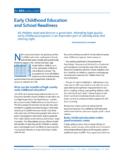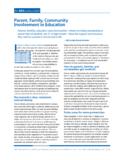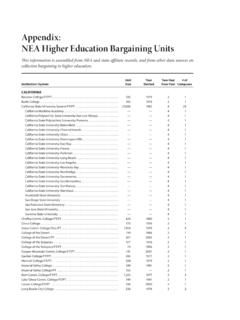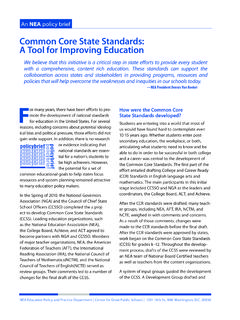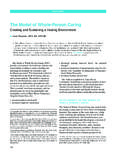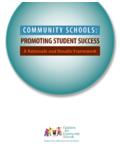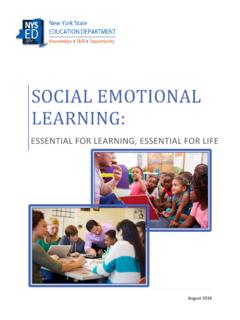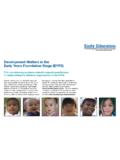Transcription of Positive Behavioral Interventions and Supports: A Multi ...
1 An NEA Policy Brief Great Public Schools for Every Student Positive Behavioral Interventions and Supports: A Multi -tiered framework that Works for Every Student The most effective tool teachers have to handle problem behavior is to prevent it from oc- curring in the first place. Positive Behavioral Interventions and Supports (PBIS) programs help teachers recognize the significance of classroom management and preventive school disci- pline to maximize student success. PBIS strategies are critical to providing all young people with the best learning environment. NEA President Lily Eskelsen Garc a PBIS is a prevention framework that this context, teaching behavior as relentlessly as works for all students P.
2 We teach reading or other academic content is the ositive Behavioral Interventions and Sup- ultimate act of prevention, promise, and power ports (PBIS) is a general term that refers to underlying [ Positive Behaviorial Supports] PBS. Positive Behavioral Interventions and sys- and other preventive Interventions in America's tems used to achieve important behavior changes. schools. 2. PBIS was developed as an alternative to aversive Interventions used with students with significant disabilities who engaged in extreme forms of self Legislation calls for Positive Behavioral injury and PBIS is not a new theory Interventions and Supports of behavior, but a behaviorally based systems Positive Behavioral Supports has held a approach to enhancing the schools' ability to unique place in special education law since design effective environments that are conducive Congress amended the Individuals with to quality teaching and learning.
3 Disabilities Education Act (IDEA) in 1997. The National Education Association (NEA) views Referred to as Positive Behavioral Interven- PBIS as a general education initiative, though its tions and Supports in IDEA, PBIS is the only impetus is derived from the special education approach to addressing behavior that is spe- law, the Individuals with Disabilities Education cifically mentioned in the law. This emphasis Act (IDEA). PBIS improves the social culture and on using functional assessment and Positive the Behavioral climate of classrooms and schools approaches to encourage good behavior which ultimately lead to enhanced academic remains in the current version of the law as performance.
4 Viewed as outcomes, achievement amended in 2004. and behavior are related; viewed as causes of each other, achievement and behavior are unrelated. In An NEA Policy Brief PBIS implementation PBIS is a Multi -tiered system designed to be inclusive of Successful PBIS programs are dependent upon the en- all environments and link research-validated practices. tire school community. The principles and tenets of PBIS Attention is focused on creating and sustaining primary are the same as those represented in Universal Design (school wide), secondary (classroom), and tertiary for Learning (UDL) and Response to Intervention (RTI) as (individual) systems of support that improve results for they include universal screening, continuous progress desired behaviors.
5 The primary prevention is school- monitoring, data-based decision making, implementation wide for all students, staff, and settings. The secondary fidelity, and evidence-based Interventions . PBIS is not a prevention is for a specialized group of students who manualized, scripted strategy or curriculum. It requires exhibit at-risk behaviors and the tertiary prevention adopting and organizing evidence-based Behavioral would be for those students who need specialized, Interventions into an integrated continuum that enhances individualized supports for at-risk behaviors. academic and social behavior outcomes for all students.
6 Implementing evidence-based intervention practices Every school has a unique climate, so a one size fits all are the key to a successful PBIS program. Components approach is not as effective as Interventions based on include but are not limited to: the needs of the learning community. School-wide PBIS. includes proactive strategies for designing, teaching, and School-Wide supporting appropriate student behaviors. A continuum Leadership team of PBIS for all students within a school is implemented Behavior purpose statement in all areas of the environment (classrooms, hallways, restrooms, and busses).
7 Set of Positive expectations and behaviors Procedures for teaching school and classroom expected behaviors In 1972, the court in Mills v. Board of Education of the District of Columbia (348 866 ( Continuum of procedures for encouraging/. 1972)) found that students with disabilities were discouraging desired behavior being excluded from educational opportunities for issues related to behavior. Congress intended Individual Student to address this exclusion in the Individuals with Behavioral competence at school and district levels Disabilities Education Act, as the Supreme Court in Function-based behavior support planning Honig v.
8 Doe (484 305 (1988)) clarified, saying: Team- and data-based decision making Congress very much meant to strip schools of the unilateral authority they had traditionally employed Targeted social skills and self management to exclude disabled students, particularly emotion- Individualized instructional and curricular ally disturbed students, from school (p. 323). accommodations Classroom School-wide Maximum structure and predictability in routines 2 NEA Education Policy and Practice Department | Center for Great Public Schools | 1201 16th St., NW, Washington, 20036. An NEA Policy Brief Positively stated expectations taught, posted, IDEA's Requirements to Use reviewed, and supervised Functional Behavioral Assessments and Consider PBIS.
9 Maximum engagement through high rates of op- portunities to respond IDEA requires: Continuum of strategies to acknowledge appropriate The IEP team to consider the use of Positive behaviors and responding to inappropriate behavior Behavioral Interventions and Supports for any student whose behavior impedes his or her learning or the learning of others (20 Congress recognized the need for schools to use 1414(d)(3)(B)(i)). evidence-based approaches to proactively address the Behavioral needs of students with disabilities. A functional Behavioral assessment when a Thus, in amending the Individuals with Disabilities child who does not have a behavior interven- Education Act both in 1997 and in 2004, Congress tion plan is removed from his or her current explicitly recognized the potential of PBIS to placement for more than 10 school days ( prevent exclusion and improve educational results suspension) for behavior that turns out to be a in 20 1401(c)(5)(F): manifestation of the child's disability (20 1415(k)(1)(F)(i)).
10 (5) Almost 30 years of research and experience has demonstrated that the education of children A functional Behavioral assessment, when ap- with disabilities can be made more effective by propriate, to address any behavior that results in a long-term removal (20 1415(k)(1)(D)). (F) providing incentives for whole-school approaches, scientifically based early reading programs, Positive Behavioral Interventions and PBIS works for all of us supports, and early intervening services to reduce NEA recognizes that professional development is critical the need to label children as disabled in order to proper implementation of PBIS and the improved be- to address the learning and Behavioral needs of havioral outcomes that PBIS can foster.
